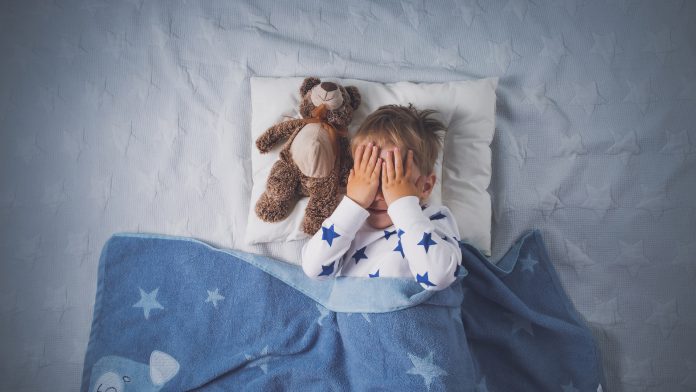
Children with insomnia symptoms are likely to persist with them as young adults and are significantly more likely to develop an insomnia disorder in early adulthood compared to children without sleeping difficulties.
Insomnia causes regularly sleeping problems but can improve by changing sleeping habits. Causes of this condition include stress, noise, and uncomfortable beds. Insomnia symptoms include waking up several times a night, feeling irritable during the day and lying awake at night.
The new study is the first long-term cohort to describe the developmental trajectories of childhood insomnia symptoms through adolescence and into young adulthood.
The new research, carried out by Penn State College of Medicine, was published in Pediatrics.
Children and adults with insomnia symptoms
The study began in the year 2000 and was designed as a random, population-based study of children aged 5-12 years. Children and their parents provided reports of the children’s insomnia symptoms – defined as moderate-to-severe difficulties initiating and/or maintaining sleep. Furthermore, the children took part in an objective in-laboratory sleep study using polysomnography, which can identify sleep apnoea and other indicators such as the amount and quality of sleep. The team studied 502 children 7.4 years later as adolescents (median 16 years old) and 15 years later as young adults (median 24 years old).
“Young adulthood is a stage in life where there is a documented increase in the severity and prevalence of physical and mental health problems, such as cardiovascular disease and suicide rates,” said Julio Fernandez-Mendoza, associate professor of psychiatry and behavioural health. “Sleep disorders — especially sleep apnoea and insomnia — are linked with poorer cardiovascular and mental health. Given that up to 25% of children, 35% of adolescents and 45% of young adults suffer from insomnia symptoms, we were interested in learning how these symptoms evolve over time as the child grows into adulthood.”
The team uncovered that 43% of children with insomnia symptoms continued to suffer through adolescence into adulthood. Although around 27% of children with insomnia symptoms experienced remission of symptoms by adolescence, almost 19% experienced an increase and decrease of symptoms in adulthood. Additionally, the team of researchers found that amongst children without insomnia symptoms, around 15% of them developed insomnia symptoms in the transition to adolescence and persisted with them into adulthood, and another 21% newly developed them in young adulthood. Around 16% of these children without insomnia symptoms experienced a pattern of increased and decreased symptoms.
“We know that not everyone who complains of insomnia symptoms has the same degree of sleep disturbance when sleep is measured objectively in the laboratory, so it was important that our study included these objective in-lab measurements in addition to the self-reports,” said Fernandez-Mendoza.”
Indeed, the study found that insomnia symptoms in adolescents who slept short in the lab were 5.5 times more likely to worsen into adult insomnia, while those who reported the same insomnia symptoms and slept normally in the lab were not at increased risk of worsening into adult insomnia.
“The key finding of this study is that insomnia symptoms in childhood are much more likely to persist over time than we previously believed,” said Fernandez-Mendoza. “Those with insomnia symptoms and laboratory-measured short sleep duration are much more likely to evolve to develop a clinical condition in early adulthood, and not just to persist with the symptoms. So, parents and clinicians should not assume that insomnia symptoms are benign complaints that will go away with age. That’s not what our study shows for a significant proportion of youth.”
Sleeping problems as adults
Fernandez-Mendoza added that many adults who have insomnia may have had problems sleeping as a child.
“Although adults’ sleep issues tend to be triggered by their most recent life stressors, for some people, their insomnia may track back to sleep problems starting in childhood,” he said.
Although the team did not investigate the underlying causes for children’s sleep issues, Fernandez-Mendoza said the primary causes are typically ‘behavioural,’ such as when a child does not want to go to sleep or needs a parent in the room to fall asleep or resume sleep; psychiatric and behavioural disorders, such as attention deficit hyperactivity disorder, autism, or mood disorders; and medical conditions, such as headaches or gastrointestinal problems. However, he emphasised that gender, race, and socioeconomic factors need always to be considered.
“We know there are health disparities in insomnia symptoms,” said Fernandez-Mendoza. “For example, our prior studies showed that females after puberty; racial and ethnic minorities, specifically Black/African American; and children from low socioeconomic households are more likely to have insomnia symptoms that persist in the transition to adolescence.”
Fernandez-Mendoza noted that the team’s findings suggested that childhood insomnia symptoms require early intervention, whilst adolescence is a critical time to address chronic sleep issues.
Interventions can include behavioural therapy for behavioural insomnia of childhood and appropriate treatments for medical or psychiatric conditions. The first-line intervention in adults is cognitive behavioural therapy for insomnia (CBTI), which is also demonstrated to be highly effective in youth, particularly in adolescents.
In addition to examining the trajectory of insomnia symptoms over time, the researchers also collected data on health outcomes and are currently in the process of finalising the publication of those data.
“We know that poor sleep is related to adverse health outcomes,” said Fernandez-Mendoza. “We suspect that many children who experience insomnia symptoms that persist into adulthood will also suffer from some negative health consequences.”
























